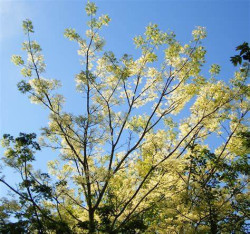Phellodendron - Lescol (Fluvastatin) Interaction
Herbal: Phellodendron
Also Known As: Phellodendron amurense, Amur Cork Bark, Amur Cork Tree, Amur Corktree, Corktree, Cortex Phellodendri, Huang Bai, Huang Bo, Huangbai, Phellodendri Cortex
Drug: Fluvastatin
Brand names:
Lescol, Lescol XL

Medical Content Editor Dr. Brian Staiger, PharmD
Last updated
Jul 06, 2025
Interaction Details
Fluvastatin is classified as belonging to the following category: Cytochrome P450 2C9 (Cyp2C9) Substrates
Theoretically, phellodendron might increase serum levels of drugs metabolized by CYP2C9.
Phellodendron contains berberine. Preliminary clinical research shows that berberine can inhibit CYP2C9. Theoretically, phellodendron might also inhibit CYP2C9.
Interaction Rating
Likelihood of Occurrence
PossibleInteraction has been documented in animal or in lab research, or the interaction has been documented in humans but is limited to case reports or conflicting clinical research exists
References
- Guo, Y., Chen, Y., Tan, Z. R., Klaassen, C. D., and Zhou, H. H. Repeated administration of berberine inhibits cytochromes P450 in humans. Eur J Clin Pharmacol 2012;68(2):213-217.
Phellodendron Overview
 Phellodendron amurense, also known as Amur cork tree, is a deciduous tree native to China, Korea, and Japan. It belongs to the Rutaceae family and is valued for its medicinal properties. The bark of Phellodendron amurense is used in traditional Chinese medicine for its purported anti-inflammatory, antimicrobial, and antioxidant effects. It contains compounds such as berberine, which is believed to contribute to its therapeutic properties. Phellodendron amurense has been studied for its potential to manage conditions like diabetes, inflammation, and cancer.
Phellodendron amurense, also known as Amur cork tree, is a deciduous tree native to China, Korea, and Japan. It belongs to the Rutaceae family and is valued for its medicinal properties. The bark of Phellodendron amurense is used in traditional Chinese medicine for its purported anti-inflammatory, antimicrobial, and antioxidant effects. It contains compounds such as berberine, which is believed to contribute to its therapeutic properties. Phellodendron amurense has been studied for its potential to manage conditions like diabetes, inflammation, and cancer.
Fluvastatin Overview
-
Fluvastatin is used together with diet, weight loss, and exercise to reduce the risk of heart attack and stroke and to decrease the chance that heart surgery will be needed in people who have heart disease or who are at risk of developing heart disease. Fluvastatin is also used to decrease the amount of fatty substances such as low-density lipoprotein (LDL) cholesterol ('bad cholesterol') and triglycerides in the blood and to increase the amount of high-density lipoprotein (HDL) cholesterol ('good cholesterol') in the blood. Fluvastatin may also be used to decrease the amount of cholesterol and other fatty substances in the blood in children and teenagers 10 to 17 years of age who have familial heterozygous hypercholesterolemia (an inherited condition in which cholesterol cannot be removed from the body normally). Fluvastatin is in a class of medications called HMG-CoA reductase inhibitors (statins). It works by slowing the production of cholesterol in the body to decrease the amount of cholesterol that may build up on the walls of the arteries and block blood flow to the heart, brain, and other parts of the body.
-
Accumulation of cholesterol and fats along the walls of your arteries (a process known as atherosclerosis) decreases blood flow and, therefore, the oxygen supply to your heart, brain, and other parts of your body. Lowering your blood level of cholesterol and fats with fluvastatin has been shown to prevent heart disease, angina (chest pain), strokes, and heart attacks.
Phellodendron - More Interactions
Phellodendron interacts with 1134 drugs
Interaction Rating Key
These severity listings are for informational use only. Never start, stop or otherwise change your therapy before speaking with your provider.
| Major | The combined use of these agents is strongly discouraged as serious side effects or other negative outcomes could occur. |
| Moderate | Use cautiously under the care of a healthcare professional or avoid this combination. A significant interaction or negative outcome could occur. |
| Minor | Be aware that there is a chance of an interaction. Watch for warning signs of a potential interaction. |
| Unknown | No interactions have been reported or no interaction data is currently available. |
Return to the main supplement interaction checker page
Parts of this content are provided by the Therapeutic Research Center, LLC.
DISCLAIMER: Currently this does not check for drug-drug interactions. This is not an all-inclusive comprehensive list of potential interactions and is for informational purposes only. Not all interactions are known or well-reported in the scientific literature, and new interactions are continually being reported. Input is needed from a qualified healthcare provider including a pharmacist before starting any therapy. Application of clinical judgment is necessary.
© 2021 Therapeutic Research Center, LLC
Drug descriptions are provided by MedlinePlus.
